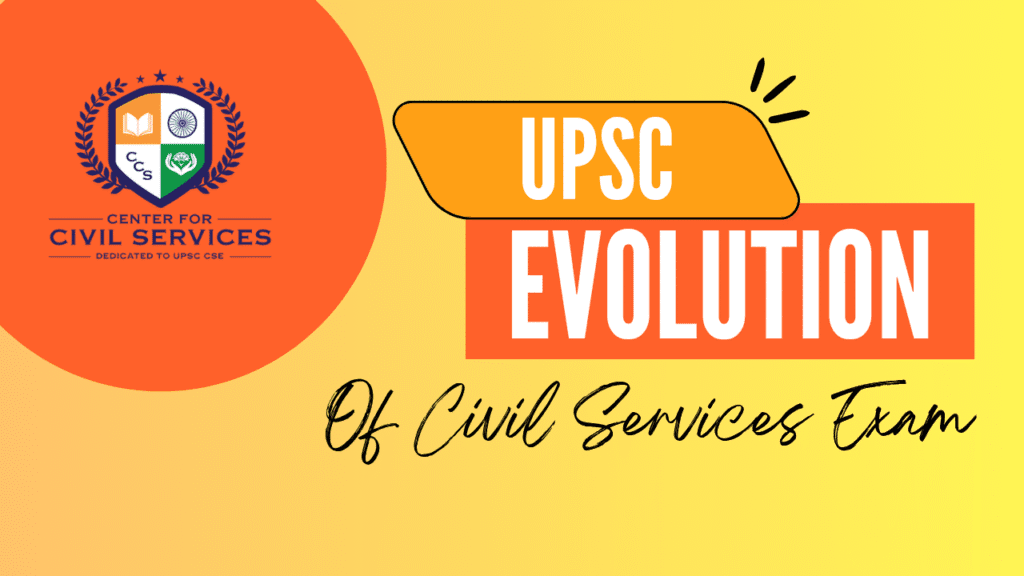
The modern UPSC Civil Services Examination (CSE) has its roots in the British-era Indian Civil Service exam, but was fully overhauled after Independence. In the early years (1950s–70s), the exam mirrored the old structure: multiple written papers (including language and optional papers) and an interview. Over time, expert committees systematically reformed the pattern.
Origins & First Reforms
The Kothari Committee (1976–79) – officially the Committee on Recruitment Policy and Selection Methods – recommended a two-stage exam (Prelims–Mains) so that “average quality would get richer as the stream proceeds.” It also urged ending the special extra papers for IAS/IFS and maintaining a common exam for all services. Accordingly, from 1979 onwards, all services have been selected through a unified CSE.
Rise of General Studies
- By the 1980s, two General Studies (GS) papers were part of the Mains, but optional papers still dominated (2–3 optionals worth 1,000+ marks).
- The Satish Chandra Committee (1989) introduced a compulsory Essay paper and raised the weight of the Interview, signaling a shift to assess broader skills.
- In the 2000s, explicit GS papers were emphasized rather than treating GS topics implicitly.
- The Y.K. Alagh Committee (2001) urged that compulsory subjects focus on national development and administration, while optionals allow specialisation.
- Alagh recommended replacing traditional optionals with interdisciplinary “compulsory” papers (e.g., Sustainable Development, Science & Tech in Society) to make the exam more relevant.
The 2013 Watershed
A high-level panel under Prof. Arun Nigavekar was set up to review the Mains syllabus. Its report, approved by the PM, dramatically rebalanced marks toward GS. The 2013 Mains allotted 1,000 marks to four GS papers and Ethics (GS1–4), vs. only 500 to optionals. Optional papers were reduced from two to one, forcing aspirants to study four GS papers instead of focusing mostly on optionals.
Evolution of Prelims & the CSAT
| Year | Change | Nature |
|---|---|---|
| Up to 2010 | One 150-mark General Studies paper + one 300-mark optional paper | Original Prelims format |
| 2011 | CSAT (GS Paper-II) added — tested comprehension, reasoning, decision-making, basic numeracy | Counts toward merit |
| 2011–14 | CSAT marks included in Prelims ranking | Merged with GS-I for merit |
| 2015 | CSAT made qualifying only (33% pass mark) | No longer affects ranking |
Official rationale: assess aptitude beyond memory, ensuring candidates have skills needed for administration.
Aspirants noted that making CSAT qualifying signaled that basic aptitude skills are essential but should only qualify candidates — while “social skills” (history, geography, etc.) determine final merit.
CSAT Controversy & Reforms
- From 2011 to 2014, CSAT affected merit ranking, disadvantaging many non-English and humanities backgrounds, sparking massive protests.
- The Nigavekar Committee observed that CSAT favored urban, English-medium aspirants and recommended reducing the English component in Prelims and strengthening Mains.
- In 2015, UPSC made CSAT qualifying only: candidates must score 33% to pass, but CSAT marks no longer count toward Prelims merit.
- Protests (2013–15) included sit-ins, candle marches and demonstrations demanding compensatory attempts for those “who suffered due to changes.”
- Protesters cited data showing selection of Hindi-medium and rural candidates fell during the CSAT years.
- UPSC’s stance: CSAT tests essential aptitude (logical reasoning, data interpretation, etc.) but should not influence overall ranking.
Key Committees Shaping the Exam
| Committee | Years | Terms of Reference | Major Recommendations |
|---|---|---|---|
| D.S. Kothari Committee | 1976–79 | Recruitment Policy & Selection Methods | Two-stage exam; abolish IAS/IFS extras; unified CSE; expand compulsory subjects + optionals |
| Satish Chandra Committee | 1989 | Review CSE scheme | Introduce Essay paper; increase Interview weight |
| V.K. Alagh Committee | 2001 | CSE Review | Introduce CSAT; emphasize GS; interdisciplinary compulsory papers |
| P.C. Hota Committee | 2004 | Civil Service Reforms | Lower entry age to 21–24; early domain training |
| S.K. Khanna Committee | 2009–10 | CSAT Implementation | Finalize CSAT format & syllabus |
| Prof. A.S. Nigavekar Committee | 2013 | Review Mains syllabus & language policy | Four GS papers + Essay; one optional; shift marks toward GS |
| 2nd Administrative Reforms Commission | 2008 | Public Administration Reforms | Propose lower age limits & attempt caps (not implemented) |
| B.S. Baswan Committee | 2015–16 | Review eligibility, syllabus & format | Lower age limit; remove medium barriers; strengthen social sciences; level playing field |

